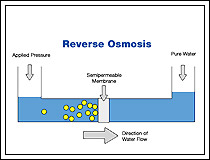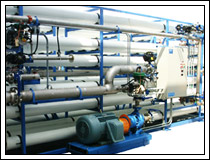Reverse Osmosis
Reverse osmosis or RO is a filtration or separation method, wherein many types of large molecules and ions are separated or removed from a solution by  exerting pressure on the solution. This is done by keeping the solution on one side of a selective or a semipermeable membrane, i.e. a membrane which is restrictive to particles like salt, natural minerals and other organic compounds. This way the solute is retained on the pressurized side of the porous membrane, whereas the pure solvent is allowed to freely pass to the other side of the same membrane through the small pores. exerting pressure on the solution. This is done by keeping the solution on one side of a selective or a semipermeable membrane, i.e. a membrane which is restrictive to particles like salt, natural minerals and other organic compounds. This way the solute is retained on the pressurized side of the porous membrane, whereas the pure solvent is allowed to freely pass to the other side of the same membrane through the small pores.
How Reverse Osmosis is Different from Normal Osmosis?
As opposed to normal osmosis process where the solvent naturally moves through a membrane, generally from a region of low solute concentration to a region of high solute concentration until chemical potential equilibrium is attained, in reverse osmosis the liquid or solvent moves from high solute concentration to lower concentration with application of high pressure (external) which is in excess of the normal osmotic pressure. Thus, in short, reverse osmosis is just the reverse process of normal osmosis procedure.
Applications & Uses of Reverse Osmosis
- One of the best known uses of reverse osmosis is in drinking or cooking water purification, both in a commercial and residential scale. Especially,
 portable RO water processors are used to purify household drinking water in rural areas where the local water supply is of substandard or low quality. portable RO water processors are used to purify household drinking water in rural areas where the local water supply is of substandard or low quality.
- Apart from household drinking water, reverse osmosis water purifiers are employed to purify rainwater collected from storm drains. This purified water is then utilized for processes like landscape irrigation and industrial cooling.
- Another key application of reverse osmosis is in car washing. The RO technique is applied during the final vehicle rinse so that the washed vehicle dries perfectly without any water spotting. This eliminates the need of time-consuming hand drying as well as expensive vehicle drying equipment such as air blowers.
- In industrial settings, reverse osmosis is used to remove minerals from boiler water at power plants.
- In the food industry, especially in the dairy industry, RO is used in processing whey protein powders. The process is also widely used in juice and wine concentration and taint removal in the wine industry.
- Last but not the least, reverse osmosis is used in production of hydrogen, maple syrup production, in dialysis during kidney malfunctioning, and in reef aquarium keeping.
|